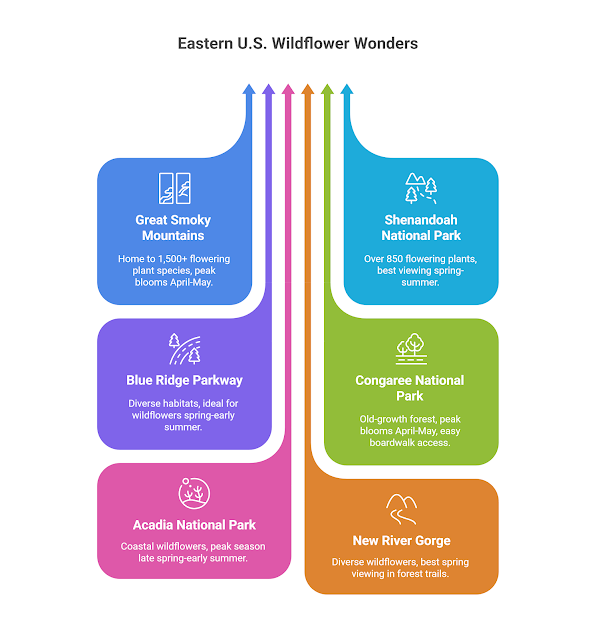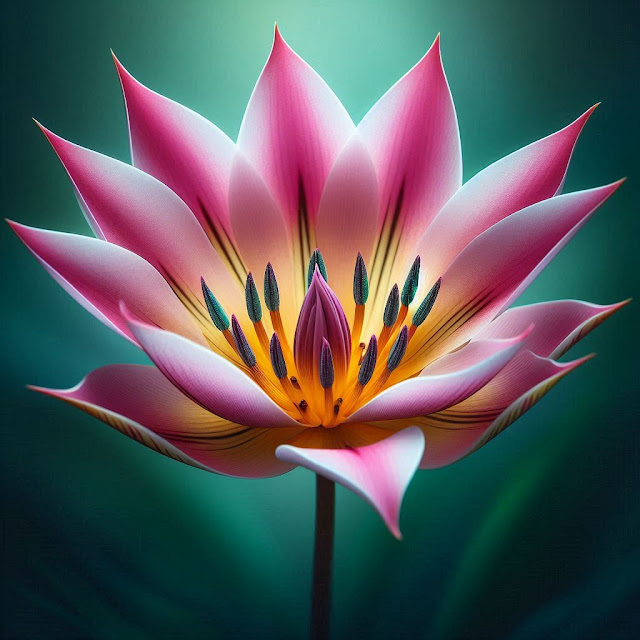Wildflower Wonders: Your Field Guide to Spring's Most Spectacular Trail Blooms
Spring has arrived, and with it
comes nature's most colorful show - wildflowers! If you've ever wandered a
trail and wondered about those vibrant blooms dotting the landscape, you're not
alone. Let's explore how to identify common spring wildflowers, where to find
spectacular displays, and why these fleeting beauties deserve our attention.
Why Spring Wildflowers Capture Our Hearts
There's something magical about
rounding a bend on your favorite hiking trail and encountering a meadow ablaze
with color. After winter's monochrome palette, these first splashes of purple,
yellow, and white feel like nature's celebration.
Spring ephemeral wildflowers don't
stick around long - they race to complete their life cycle before the tree
canopy fills in and blocks precious sunlight. Their fleeting nature makes
spotting them even more special, like catching a rainbow before it fades.
Essential Wildflower Identification Basics
Before we dive into specific
flowers, let's cover some identification fundamentals:
Look Beyond the Bloom
While flowers are the showstoppers,
leaves, stems, and growth patterns provide crucial identification clues:
- Are leaves opposite or alternate on the stem?
- Is the leaf edge smooth, toothed, or lobed?
- Does the plant grow as a single stem or in clumps?
Count Those Petals
The number of petals often helps
narrow down plant families:
- Four petals might indicate a member of the mustard family
- Five petals could suggest the rose or buttercup family
- Multiples of three petals often point to lily relatives
Habitat Hints
Where you find a flower tells you a
lot about what it might be:
- Sunny, dry hillsides attract different species than shady, moist woodlands
- Elevation changes dramatically influence which flowers appear and when
- Some wildflowers are habitat specialists, while others are generalists
10 Common Spring Wildflowers to Spot on Your Hikes
1. Trillium (Wake-Robin)
With their perfect symmetry of
three petals and three leaves, trilliums are woodland royalty. These
forest-floor dwellers emerge before the tree canopy fills in.
Where to find them: Mature
deciduous forests with rich soil, often near streams or in ravines.
Fun fact: Ants help spread trillium
seeds in a process called myrmecochory. The seeds contain a fatty appendage
that ants love to eat, so they carry the seeds to their nests, effectively
planting them in new locations.
2. Bluebonnets (Lupine)
These iconic spikes of blue,
purple, or occasionally white flowers are actually members of the pea family.
Where to find them: Sunny meadows
and hillsides, particularly abundant in Texas and other southern states.
Fun fact: While Texas made their
bluebonnet the state flower, they didn't specify which species - which turned
out to be wise since botanists keep reclassifying them!
3. Spring Beauty (Claytonia)
These delicate pink-striped blooms
might be small, but they form breathtaking carpets in early spring.
Where to find them: Deciduous
woodlands, often in large colonies that create pink drifts across the forest
floor.
Fun fact: Spring beauties are
edible, with starchy tubers that taste a bit like potatoes. But please don't
harvest them from the wild - their colonies are precious!
4. Virginia Bluebell (Mertensia)
These bell-shaped blooms transition
from pink to blue as they mature, creating multi-colored clusters.
Where to find them: Rich woodland
soils, often near streams or in floodplains.
Fun fact: The color change from
pink to blue happens as the flower's pH changes - nature's own litmus test!
5. Bloodroot (Sanguinaria)
Named for its red sap, bloodroot
produces pristine white flowers with golden centers that open only on sunny
days.
Where to find them: Deciduous
woodlands with good drainage.
Fun fact: Each bloodroot flower is
wrapped in a single leaf that unfurls like a protective cape around its bloom.
6. Dutchman's Breeches (Dicentra)
These whimsical white flowers truly
resemble tiny pants hanging upside down on a clothesline.
Where to find them: Rich woodlands,
often growing alongside other spring ephemeral wildflowers.
Fun fact: These flowers are adapted
for bumblebee pollination - their long bodies can push into the
"breeches" to reach the nectar.
7. Wild Columbine (Aquilegia)
With distinctive spurred petals,
columbines bounce on thin stems like tiny dancers in the breeze.
Where to find them: Rocky outcrops,
woodland edges, and partially shaded slopes.
Fun fact: Hummingbirds adore
columbines, as their long nectar spurs seem perfectly designed for their bills.
8. Jack-in-the-Pulpit (Arisaema)
This unusual wildflower features a
hooded "pulpit" (spathe) surrounding a central "Jack"
(spadix).
Where to find them: Moist woodlands
and forested wetlands.
Fun fact: Individual plants can
change sex from year to year depending on their energy reserves - talk about
gender fluidity!
9. Marsh Marigold (Caltha)
These bright yellow buttercup
relatives light up wet areas like living sunshine.
Where to find them: Wetlands,
stream banks, and marshy meadows.
Fun fact: Despite their common
name, marsh marigolds aren't true marigolds at all - they're members of the
buttercup family.
10. Shooting Star (Dodecatheon)
With reflexed petals pointing
backward and stamens pointing forward, these flowers truly resemble small
comets streaking through the woods.
Where to find them: Moist meadows,
open woodlands, and prairies.
Fun fact: Shooting stars are
buzz-pollinated - bumblebees grab onto the flower and vibrate their wing
muscles at just the right frequency to shake loose the pollen.
Top Wildflower Viewing Locations Across America
Eastern Woodlands
- Great Smoky Mountains National Park (Tennessee/North Carolina) - Boasts over 1,500 flowering plant species with peaks in April and May
- Shenandoah National Park (Virginia)
- The famous Skyline Drive offers stunning wildflower views, particularly in
mid-April through May.

Midwestern Prairies
- Tallgrass Prairie National Preserve (Kansas) - Spectacular displays of prairie flowers from May through September
- Nachusa Grasslands (Illinois) - A restored prairie showcasing native wildflowers throughout the growing season
Western Mountains
- Antelope Valley California Poppy Reserve (California) - Famous for its orange poppy blankets in March and April
- Columbia River Gorge (Oregon/Washington) - Features diverse habitats with different wildflower peaks from April through June
Southern Fields
- Lady Bird Johnson Wildflower Center (Texas) - Cultivated displays of native wildflowers with educational resources
- Crested Butte (Colorado) - The "Wildflower Capital of Colorado" with peak viewing in July
Wildflower Etiquette: Admire Don't Acquire
As wildflower enthusiasts, it's our
responsibility to protect these natural treasures:
- Stay on designated trails to avoid trampling delicate vegetation
- Take photos, not flowers - many wildflowers don't transplant well anyway
- Learn which species are rare or protected in your area
- Consider joining local conservation efforts to preserve wildflower habitats
Remember the outdoor enthusiast's
mantra: "Take only pictures, leave only footprints."
Essential Gear for Wildflower Identification
Ready to become a wildflower
detective? Here's what you'll need:
- Field guide specific to your region - Local guides are more helpful than general ones
- Hand lens or magnifying glass - Small 10x magnifiers reveal incredible flower details
- Smartphone with a plant ID app - Apps like iNaturalist, Seek, or PlantNet can help with identification
- Camera - Document your finds to compare with references later
- Notebook - Record locations, dates, and growing conditions to build your personal phenology calendar.
When Timing is Everything: Bloom Calendars
Wildflower displays are ephemeral
and highly dependent on local conditions. A few strategies to improve your
timing:
- Follow local naturalist groups online - They often post "what's blooming now" updates
- Check with visitor centers - Rangers and staff track bloom progress
- Start your own bloom journal - Note when and where you see specific flowers each year
- Visit the same locations every 1-2 weeks during spring - You'll be amazed at how quickly the display changes
From Wildflower Watcher to Wildflower Advocate
Once you've fallen under the spell
of spring wildflowers, consider taking your passion further:
- Volunteer for wildflower surveys or citizen science projects
- Create a native wildflower garden at home to support pollinators
- Advocate for roadside wildflower preservation in your community
- Share your knowledge and enthusiasm with others, especially children
Final Thoughts: The Therapeutic Power of Wildflower Watching
In our busy, technology-dominated
lives, wildflower watching offers a perfect excuse to slow down. There's
something meditative about carefully examining a tiny bloom, appreciating its
intricate architecture, and connecting to the ancient cycles of nature.
As you head out this spring,
remember that identification is just one part of the experience. Sometimes the
greatest joy comes not from naming the flower, but from simply witnessing its
existence - a small but perfect expression of life's remarkable diversity.
Happy wildflower hunting!
About the Author
Meet Britney! She's a dynamic entrepreneur with a zest for life. Britney's love for animals shines through in everything she does. She enjoys vacationing at the beach, where she finds peace and relaxation. A Halloween enthusiast, Britney brings a touch of spooky fun to her creative endeavors. Her passion for fitness and wellness drives her to explore new ways to stay healthy and active. Britney’s diverse interests make her contributions to our blog both inspiring and enjoyable.


.png)





.png)


.png)

Comments
Post a Comment